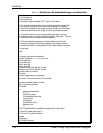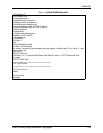
PostScript
1-40 Guide to Using Page Description Languages
Summary
To minimize imaging time, make sure that no data
transformations need to be performed at the printer. Order the
image data so that the fast and slow scan directions match the
output fast and slow scan directions when the image is in the
correct orientation on the page. With the image data correctly
ordered, arrange the PostScript transformations so that they
specify the position and orientation of the image relative to the
PostScript default image and user coordinate systems.
Scan resolution and scaling
Just as rotation of an image is often required to produce correct
output, scaling is also often required. To reduce imaging time,
present the data so that scaling is not required; supply data for
300 dots per inch of output size in both dimensions.
Part of the image-to-user space transformation for any image is
the scaling that takes image coordinates to physical coordinates
in user space. DocuPrint splits the transformation into two parts.
The
scale
operator is needed as part of the transformation from
the unit square in user space (1 unit equals 1 point, which equals
1/72 inches) to the destination rectangle or parallelogram.
In the following example, the number of samples in each
dimension is divided by the input resolution, giving the size of the
image in inches, which is multiplied by 72 to obtain the size in
points. The two computed values are used as scale factors to
take the unit square to the size of the original image.
As with rotation, the image-to-user space transformation
specifies the output size of the image, and internal scaling may
or may not be required, depending on the data available. In the
scaling and resolution example above, 300 samples per inch of
output size were provided, and output scaling is not required.
Table 1-3.
Scaling and resolution example
/lines 3296 def % lines in the image
/bpl 2528 def % bits per line
/res 300.0 def % spots per inch of image resolution
.
.
.
bpl res div 72 mul lines res div 72 mul scale


















